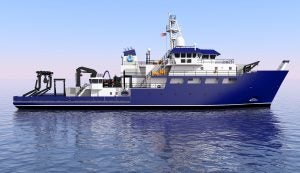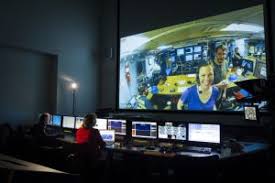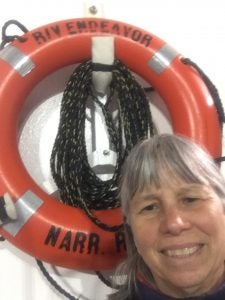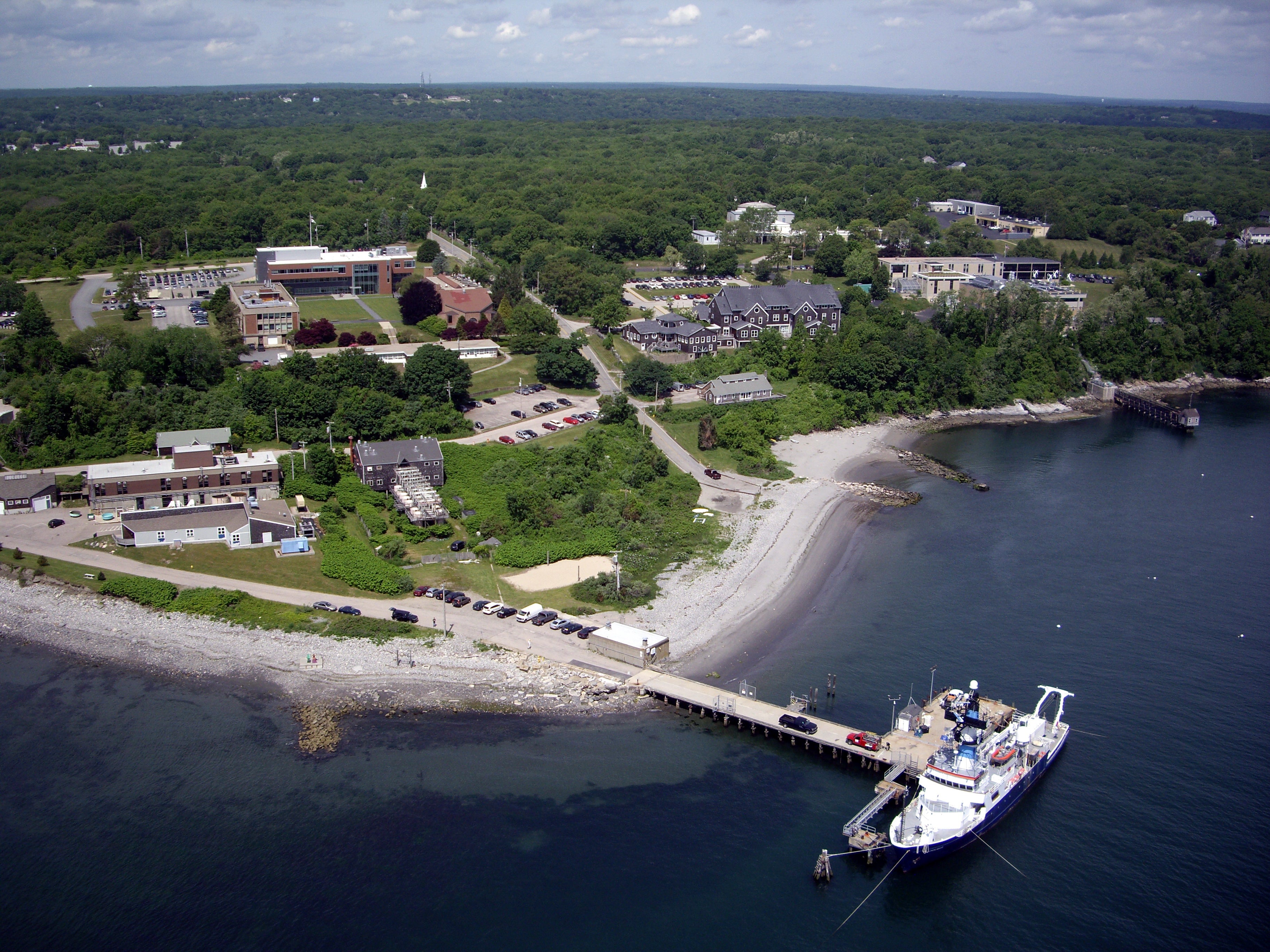The Bay Campus was all abuzz last Thursday afternoon as the official word was received from the National Science Foundation (NSF) that the East Coast Oceanographic Consortium (ECOC), led by the University of Rhode Island’s Graduate School of Oceanography (URI GSO), was selected to receive a new oceanographic research ship, valued at over $100 million. This Regional Class Research Vessel (RCRV) will be finished in 2021 and homeported at URI’s Narragansett Bay Campus. (See photo of GSO’s present ship, the 185 ft R/V Endeavor, at the GSO dock, right.)
As GSO Dean Bruce Corliss said, “This is tremendous news for the Consortium members, URI, and the state of Rhode Island. This new ship and our consortium will provide cutting edge technology and exciting new opportunities for research, education and outreach in ocean science and exploration.”

According to the press release sent out by URI,
Regional Class Research Vessels conduct operations in the coastal ocean ranging from near-shore environments to the outer continental rise, as well as the open ocean. The new ship will be 199 feet long and 41 feet wide and will feature improved science labs, more workspace, state-of-the-art technologies, and more comfortable berthing. The ship will be able to cruise at 11.5 knots for up to 21 days. It will also include a dynamic positioning system that enables ships to remain in one exact spot for long periods and will allow operation of remote operated vehicles. The ship will carry a crew of 13 and up to 16 scientists and have a cruising range of 5,400 nautical miles. The vessel’s endurance, draft, ice classification and science mission equipment are tailored for essential science throughout the Atlantic Ocean and adjoining seas.

Here are some reasons why this new ship (see artist’s rendering at right) is important for Rhode Island, why a coastal oceanographer (me) is so excited about this new ship, and why the Rhode Island general public should be very excited about the future of ocean research in our state.
The Value of a New Research Vessel for Rhode Island
The new vessel announcement is important for Rhode Island because a prestigious national institution, NSF, has acknowledged that GSO and its consortium partners – the Woods Hole Oceanographic Institution and the University of New Hampshire School of Marine Science and Ocean Engineering along with 13 associate members (Bermuda Institute of Ocean Sciences; Bigelow Laboratory for Ocean Sciences; Brown University; Lamont Doherty Earth Observatory of Columbia University; Harvard University; Ocean Exploration Trust; University of Maine; University of Miami; University of Puerto Rico; University of Massachusetts, Dartmouth; University of Massachusetts, Boston; Florida Institute of Oceanography; and the University of South Florida) – conduct significant ocean-based research. (See photo below left of scientists carrying out research on the back deck of the R/V Endeavor.)The NSF is providing over $100 million in funds to construct a state of the art research vessel for the consortium’s use. This is one of only three such ships being constructed nationwide.

In addition, NSF realized that the Narragansett Bay Campus was the best place to dock the vessel in terms of personnel and facilities. This is significant in terms of the “blue economy” of Rhode Island because it is likely that NSF and other federal sponsors, including the National Oceanic and Atmospheric Administration and the Office of Naval Research, will continue to give URI approximately $5 million yearly to operate the vessel which includes crew, food, fuel, planned maintenance, safety training, and science logistics.
Also it is expected that what is now called the “Rhode Island Endeavor Program” will continue with the new ship. This program uses state funds to cover up to 20 days at sea on our research vessel for Rhode Island scientists, graduate students, undergrads, and K-12 teachers to participate in scientific research and educational opportunities. (See photo at right of students on such a cruise in April 2018.)
Why An Ocean-Going Ship Benefits Coastal Research

So why should a coastal ecologist care about this ship? In a very practical sense, what is going on offshore influences what is going on in Narragansett Bay and all of Rhode Island’s estuaries. Just a few examples of those influences include:
- Storms formed offshore that impact our coast and cause erosion;
- “Red tides” and other harmful algal blooms that may originate offshore and migrate towards local waters;
- The exchange of nutrients between nearshore and offshore waters that helps to feed the production in the bay;
- Invasive species that are swept into coastal waters from longshore or offshore currents;
- Ocean-going ships can track changes in water circulation that may ultimately affect sea level rise that will directly impact our coast;
- Offshore factors such as water temperature that affect when fish migrate into the Bay, which in turn affects the fishing industry.

Having a modern research vessel conducting research up and down the Atlantic Seaboard will provide Rhode Island with an immense amount of data that will be useful for managing and protecting the state’s coastal waters. (See photo to right of water circulation and photo below, left, of a large storm system.)
How Rhode Islanders in General Benefit from a New Ship
By having a brand-new research vessel in their own back yard, Rhode Islanders are afforded opportunities others can only dream about. Some may have the opportunity to go on a research cruise, as mentioned above. Others may watch a live streaming broadcast of research activities on the ship via telepresence from either their home computer or the two-story-tall screen at Mission Control in the Inner Space Center at GSO (see photo below, center). Some students will have an opportunity to learn about the open ocean via broadcasts to their classrooms. Others will be some of the first to hear about cutting edge ship research in the news or on GSO’s Facebook, Twitter, and Instagram accounts. Those who visit the Narragansett Bay Campus for the annual GSO Open House in October can visit the ship itself and talk to its crew (see photo below, right). Most importantly, Rhode Islanders get the satisfaction of knowing that world-class ocean science starts right here in the Ocean State.



July 17, 2018 – Volume 1, Number 5.
 This blog post was written by Veronica M. Berounsky, GSO Science Correspondent and Coastal Ecologist. She first arrived at GSO in March of 1979 as a research lab tech. In 1990 she obtained her Ph.D., working on nitrification in Narragansett Bay with the late Scott W. Nixon. She continues to be fascinated by the ecology of coastal ecosystems every day. With this blog she hopes to increase your understanding of the activities and people of GSO and the Narragansett Bay Campus. Please email any comments to her at vmberounsky@uri.edu.
This blog post was written by Veronica M. Berounsky, GSO Science Correspondent and Coastal Ecologist. She first arrived at GSO in March of 1979 as a research lab tech. In 1990 she obtained her Ph.D., working on nitrification in Narragansett Bay with the late Scott W. Nixon. She continues to be fascinated by the ecology of coastal ecosystems every day. With this blog she hopes to increase your understanding of the activities and people of GSO and the Narragansett Bay Campus. Please email any comments to her at vmberounsky@uri.edu.
Or click here to see all previous Bay Campus (B)logs.
Subscribe to the Bay Campus (B)log here.

